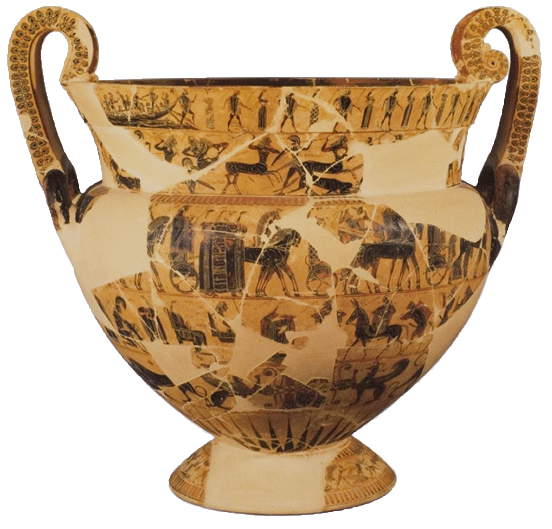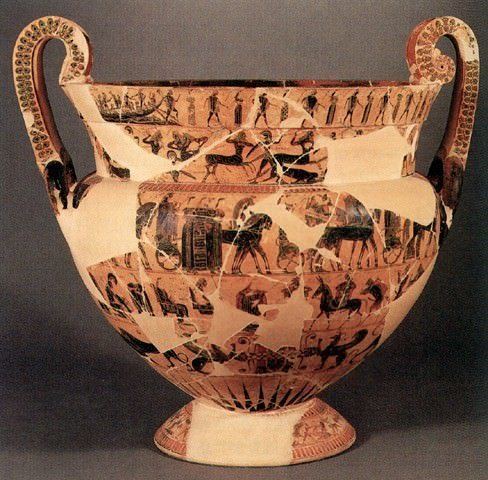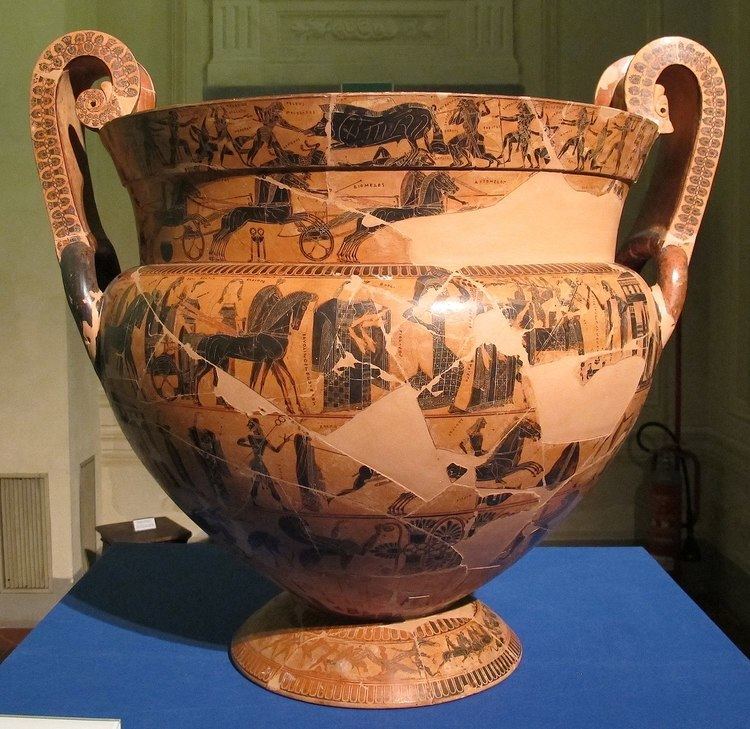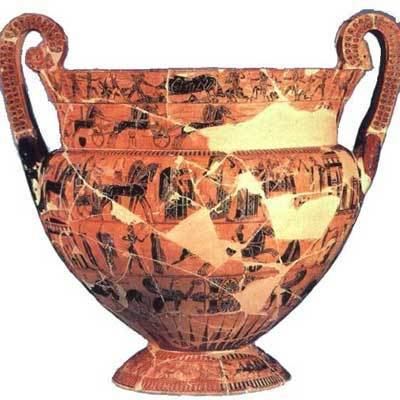 | ||
Similar Peplos Kore, Kritios Boy, Lady of Auxerre, Chigi vase, Kroisos Kouros | ||
The fran ois vase in florence
The François Vase, a milestone in the development of Greek pottery, is a large Attic volute krater decorated in the black-figure style which stands at 66 cm in height. Dated at circa 570/560 BCE it was found in 1844 in an Etruscan tomb in the necropolis of Fonte Rotella near Chiusi and named after its discoverer Alessandro François; it is now in the Museo Archeologico at Florence. It bears the inscriptions "Ergotimos mepoiesen" and "Kleitias megraphsen", meaning "Ergotimos made me" and "Kleitias painted me". It depicts over 200 figures, many with identifying inscriptions, representing a number of mythological themes. It is a topic of scholarly debate whether an overarching programme was intended. In 1900 a museum guard threw a stool at the case that contained the vase and smashed it into 638 pieces. By 1902 it had been restored by Pietro Zei, with a second reconstruction in 1973 incorporating previously missing pieces.
Contents

Fran ois vase palazzo vecchio firenze florence
Depictions

The uppermost frieze, on the neck of the krater, depicts on side A the Calydonian Boar Hunt, including the heroes Meleager, Peleus, and Atalanta. The scene is flanked by two sphinxes which are separated from it by a band of lotus blossoms and palmettes. On the other side of the vessel, this zone features the dance of Athenian youths led by Theseus who is playing the lyre, standing opposite Ariadne and her nurse.

The second band on side A shows the chariot race which is part of the funeral games for Patroclus, instituted by his friend Achilles, in the last year of the Trojan War. Here, Achilles is standing in front of a bronze tripod, which would have been one of the prizes, while the participants include the Greek heroes Diomedes and Odysseus. On side B, the painted scene depicts a battle of the Lapiths and Centaurs. The most famous of these conflicts took place at the wedding party of Pirithous and Hippodamia, which is probably depicted here, as the hero Theseus is found among the combatants, a friend of Pirithous who himself was not a Lapith, but said to be among the wedding guests. The scene also includes the demise of the Lapith hero Caeneus.

The third frieze on both sides, the highest and also most prominent one because of its location on the top of the body vessel, depicts the procession of the gods to the wedding of Peleus and Thetis. Because of its large number of figures, the procession is a suitable topic to decorate the long band. The end of the procession shows Peleus between an altar and the house where Thetis can be seen sitting inside. He is greeting his teacher, the centaur Chiron, who is heading the procession together with the divine messenger Iris, followed by many other deities.

The fourth frieze on side A depicts the ambush of Troilus by Achilles. Side B shows the return of Hephaestus to Olympus; sitting on a mule, he is led to the Olympian gods by Dionysus, followed by a group of silens and nymphs.

The fifth frieze shows sphinxes and griffins flanking lotus blossom and palmettes ornaments and panthers and lions attacking bulls, a boar, and a deer.
On the foot of the vessel, there is on both sides a depiction of the battle between the Pygmies and the cranes.
The handles are decorated as well, showing on their outer sides the so-called Mistress of Animals above a vignette showing Ajax carrying the dead Achilles. The fields on the inner sides of the handles above the rim of the pot each feature a Gorgon in motion.
